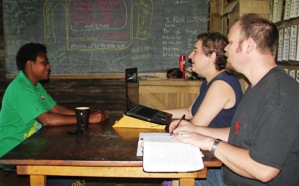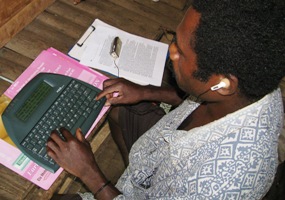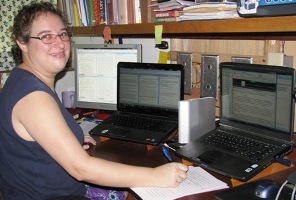
(From May 9, 2011) The second step of many in the process of translation has big names like “transfer” and “Mother Tongue Draft.” What we do is sit down with our exegetical draft where we’ve made our best attempt at Lusi, a Lusi speaker, and a voice recorder. Then we read our draft to the Lusi speaker, and he or she thinks about what we’ve said, and then they say it how they would best say it, and we write it down. This goes a paragraph at a time, a sentence at a time, or sometimes we work on words (particularly if we don’t have the right terms). Here is where we explain foreign concepts like wheat, grapes, camels, deserts, large houses that people do more than sleep in, how a king behaves, Egyptian customs, and so on to our translation helper. Here also we may back up a step and explain what we are trying to say and not succeeding. The helper may correct our Lusi and make things agree as they should, come up with new terms we might not have heard before, or say things in a different way that we hadn’t thought of, or come up with a better way to say things. Here the focus is on the details of things in the mother tongue.

The third step continues the process of “transfer” and the “Mother Tongue Draft.” On another day, after things have had a chance to percolate a bit, then we do a “Mother Tongue Draft” recording. Once again Rick sits down with our now modified draft of the passage in Lusi, a Lusi speaker, and a voice recorder. Today our focus is on the flow of the large piece of discourse.
He starts by reading the whole passage to the Lusi person. Then he goes back and goes paragraph by paragraph or large chunk by large chunk. He reads it to our Lusi helper, and he/she thinks about it, and then retells the chunk to him in his/her best Lusi. Rick continue this way through the whole passage. At the end, once the translation helper has dealt with all the pieces, he/she goes back and retells the whole passage. Because he/she is talking at normal speed, this is too fast for me to keep up with typing. Rick records the whole session and then I or someone else transcribes it later.

Once it is transcribed, and parts where my parser isn’t working well are checked with a Lusi speaker, then I compare how the translation helper dealt with the flow of the larger passage with my much choppier modified exegeted version. Then I take the best parts of his version and meld them with the best parts of meaning of my version, always looking back to the source languages and forward to how the Lusi people understand things. The hope is to have a passage then that retains the meaning of the original source languages and speaks the Lusi language clearly and well. The end result of the typing and taping in this step of getting the Bible into a Mother Tongue Draft, is that we end up with a better draft, more like they would say it, rather than me imposing my English patterns on the Lusi language.
So far we figure that we are averaging about 20-22 hours per chapter just on the first few steps. That means some are less and some are much, much more! Translation is a painstaking job of a 1000 decisions. We find ourselves tired and worn out by the end of the day. However, we are finding incredible joy in being able to do what we were sent here to do. We’ve only just begun; there are quite a few more steps and chapters to go!
Leave a Reply
You must be logged in to post a comment.